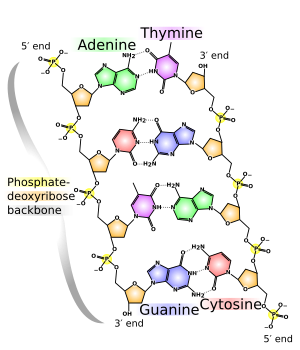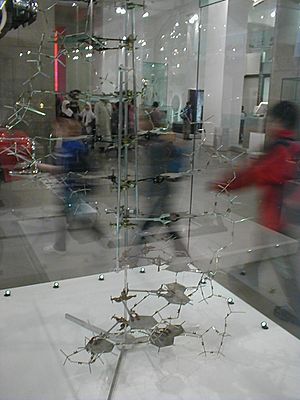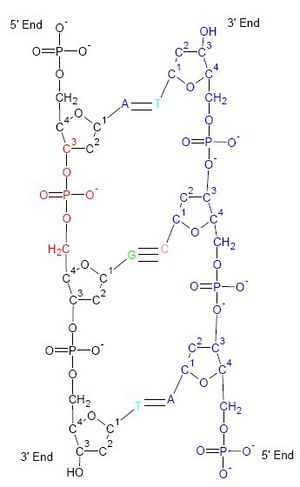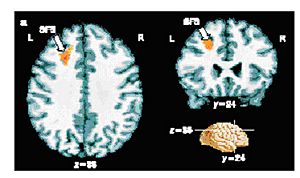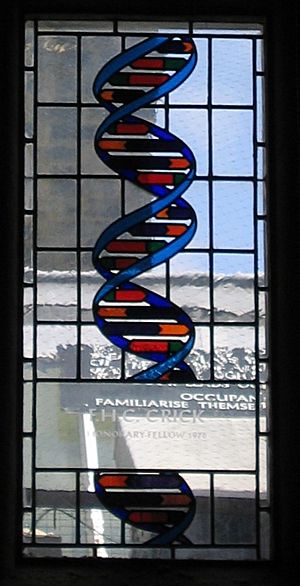Francis Crick facts for kids
Quick facts for kids
Francis Crick
|
|
|---|---|
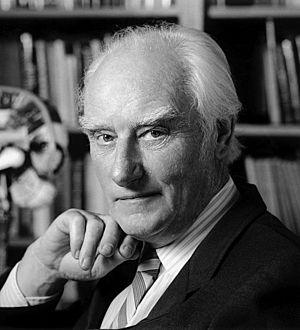 |
|
| Born |
Francis Harry Compton Crick
8 June 1916 Weston Favell, Northamptonshire, England
|
| Died | 28 July 2004 (aged 88) San Diego, California, U.S.
|
| Alma mater | |
| Occupation |
|
| Known for |
|
| Spouse(s) |
Ruth Doreen Dodd
(m. 1940; div. 1947)Odile Speed
(m. 1949) |
| Children | 3 |
| Awards |
|
| Scientific career | |
| Fields | |
| Institutions | |
| Thesis | Polypeptides and proteins: X-ray studies (1954) |
| Doctoral advisor | Max Perutz |
| Doctoral students | none |
| Signature | |
 |
|
Francis Harry Compton Crick (8 June 1916 – 28 July 2004) was an amazing English scientist. He worked with James Watson, Maurice Wilkins, and Rosalind Franklin to discover the structure of DNA. DNA is like the instruction manual for all living things. This discovery was one of the most important in science history.
Contents
Early Life and Learning
Francis Crick was born in Weston Favell, a small village in England. From a young age, he loved science and reading books. He always wanted to find answers about the world.
His uncle, Walter Crick, taught him about chemistry and photography. Francis went to Northampton Grammar School and later to Mill Hill School in London. There, he studied math, physics, and chemistry.
Crick studied at University College London (UCL) and earned his first degree in 1937. He started his PhD, but World War II interrupted his studies. During the war, he used his science skills to help the British Navy. He designed special mines. After the war, he continued his PhD at the University of Cambridge. He worked at the Cavendish Laboratory and the Medical Research Council (MRC) Laboratory of Molecular Biology.
A New Path in Science
After World War II, Francis Crick was in his early thirties. He decided to change his focus from physics to biology. He felt that physics had already made huge discoveries. He was excited about the big mysteries still waiting to be solved in biology. He believed his physics background would help him think about biology problems in new ways.
Unlocking Life's Secrets: DNA Research
Scientists knew that living things inherited traits from their parents. But they did not know how this information was passed down. They thought it had something to do with molecules inside cells, especially in the chromosomes. There were two main suspects: proteins and DNA.
DNA was known to be in chromosomes. However, some scientists thought it was too simple to carry all the complex information needed for life. Proteins seemed more complicated, so some thought they were the key.
Francis Crick was in Cambridge, England. He worked with other scientists like Max Perutz. They used a technique called X-ray crystallography. This technique helps scientists study the shape of molecules. It involves shooting X-rays at a crystal of a molecule. The pattern the X-rays make when they bounce off gives clues about the molecule's shape.
Discovering the Double Helix Structure
In the early 1950s, Francis Crick teamed up with an American scientist named James Watson. They were both very interested in solving the mystery of DNA's structure.
Other scientists were also working on this problem. These included Rosalind Franklin and Maurice Wilkins at King's College London. Rosalind Franklin was an expert in X-ray crystallography. She took incredibly clear X-ray pictures of DNA. One of her pictures, called "Photo 51," was very important. It strongly suggested that DNA had a helical (spiral) shape.
Watson and Crick used information from different sources. This included talks with Wilkins and data from Franklin's work, like Photo 51. They used this information to build models of the DNA molecule. They tried different ways to arrange the parts that make up DNA, called nucleotides.
A very important clue came from chemist Erwin Chargaff. He found that in DNA, the amount of Adenine (A) was always about the same as Thymine (T). Also, the amount of Guanine (G) was always about the same as Cytosine (C). This suggested that A always paired with T, and G always paired with C.
Using this pairing idea and clues from the X-ray images, Watson and Crick built a model of DNA that finally made sense. It was a double helix, like a twisted ladder. The sides of the ladder were made of sugar and phosphate molecules. The rungs were made of the base pairs (A with T, and G with C). These pairs were held together by weak bonds. The two strands of the helix ran in opposite directions.
This structure immediately showed how DNA could carry genetic information. It also showed how it could be copied. The order of the bases along the strands could be the code. Because A always pairs with T and G with C, each strand could be a guide to build a new matching strand. This makes an exact copy of the DNA.
Watson and Crick published their model in a scientific paper in April 1953. Rosalind Franklin and Maurice Wilkins also published papers in the same journal issue. Their papers presented experimental data that supported the model.
The Nobel Prize Recognition
For their amazing work on the molecular structure of DNA, Francis Crick, James Watson, and Maurice Wilkins received the Nobel Prize in Physiology or Medicine in 1962. Sadly, Rosalind Franklin had passed away in 1958. Nobel Prizes are not given after someone has died. However, her crucial contributions are now widely recognized and celebrated.
The Central Dogma of Molecular Biology
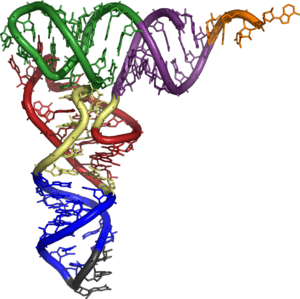
After the DNA structure was discovered, Francis Crick continued his important work. He helped us understand how genetic information is used in cells. He proposed the idea of the "central dogma" of molecular biology.
The central dogma explains how genetic information usually flows in living things:
- Information usually flows from DNA to RNA.
- Then, information flows from RNA to protein.
Think of DNA as the master blueprint in the cell's library (the nucleus). When the cell needs to build something, like a protein, it makes a temporary copy. This copy is an RNA molecule. This RNA copy then travels out of the nucleus to the cell's protein-making machines (ribosomes). There, the instructions are read to build a specific protein.
Crick's idea was that information generally does not flow backward. It does not go from protein to RNA or DNA. This was a very important idea for understanding how genes work.
Later Scientific Explorations
Francis Crick was a scientist with many interests. After his major work on DNA and the genetic code, he became very interested in the brain and consciousness. He wanted to understand how we think, feel, and are aware of the world.
He moved to California and worked at the Salk Institute for Biological Studies. He studied neuroscience. He tried to understand how the physical processes in the brain create our conscious experience. He worked with other scientists and thinkers on this complex topic. He focused on things like how we see and the purpose of sleep.
He wrote several books to explain his scientific ideas to a wider audience. These included "What Mad Pursuit" about his life in science. He also wrote "The Astonishing Hypothesis" about the scientific search for consciousness.
Personal Life
Francis Crick was married twice and had three children.
Death
Crick passed away from colon cancer on 28 July 2004. He was cremated, and his ashes were scattered into the Pacific Ocean. A public memorial was held for him at the Salk Institute in California.
Awards and Honours
Besides sharing the 1962 Nobel Prize, Francis Crick received many other awards and honours. These include the Royal and Copley medals from the Royal Society. He also received the Order of Merit in 1991. He was elected a member of the American Academy of Arts and Sciences and the United States National Academy of Sciences.
Francis Crick Medal and Lecture
The Francis Crick Medal and Lecture was created in 2003. It was funded by his former colleague, Sydney Brenner. This lecture is given every year in biological sciences. It prefers areas where Francis Crick himself worked. It is especially for younger scientists, usually under 40.
Francis Crick Institute
The Francis Crick Institute is a large biomedical research center in London, United Kingdom. It is a partnership between several major organizations. It is one of the largest centers for biomedical research in Europe.
Other Honours
- A DNA sculpture outside Clare College in Cambridge, England, has an inscription. It says: "The structure of DNA was discovered in 1953 by Francis Crick and James Watson while Watson lived here at Clare."
- A sculpture called Discovery was placed in Northampton, England. It celebrates Crick's life and his discovery of DNA.
- A green plaque was put on the front of 56 St George's Square, London. This was where Crick lived.
- In 1987, Crick received the Golden Plate Award from the American Academy of Achievement.
See also
 In Spanish: Francis Crick para niños
In Spanish: Francis Crick para niños
- Crick, Brenner et al. experiment
- Crick's wobble hypothesis
- History of RNA biology
- List of RNA biologists
- Molecular structure of Nucleic Acids (article)
- Neural correlates of consciousness


